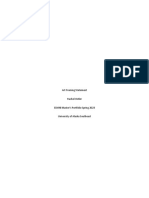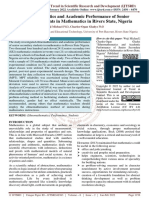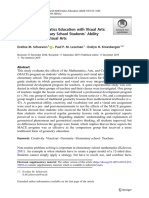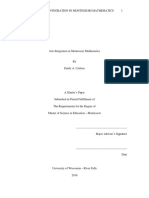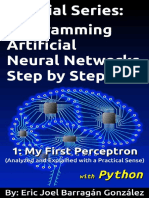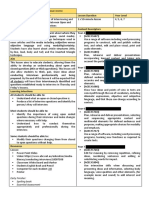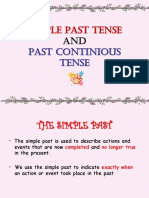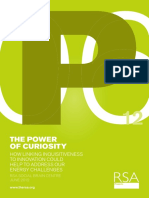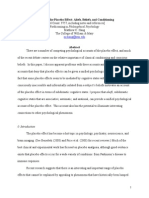Professional Documents
Culture Documents
Use of Mathematics in Deuda Naach Logic and Geometry
Copyright
Available Formats
Share this document
Did you find this document useful?
Is this content inappropriate?
Report this DocumentCopyright:
Available Formats
Use of Mathematics in Deuda Naach Logic and Geometry
Copyright:
Available Formats
Volume 7, Issue 4, April – 2022 International Journal of Innovative Science and Research Technology
ISSN No:-2456-2165
Use of Mathematics in Deuda Naach:
Logic and Geometry
Bhim Bahadur Rokaya
Mid-West University Central Campus of Education
Teaching Faculty of Mathematics Education
Abstract:- The geometric shapes seen in the body along with the dance in teaching to promote engagement and
movements in the very popular Deuda Naach (Naach learning in spatial, rhythmic, structural and symbolic aspects
means dance in Nepali language) of the Karnali region of of mathematics. Any dance enhances students' intimacy with
Nepal and the arguments used in the Deuda song show mathematical subjects and arouses interest in mathematics
the experimental, logical, and creativity of mathematics. and ultimately, real mathematics is learned.Dance has been
The major concern of this article is to explorethe use of considered as an aesthetic experience and practice for
mathematics on Deuda Naach in the Karnaliregion and centuries.It has been an entertaining work of art which has
it can be used in the teaching-learning process in been transporting the gratitude and knowledge from the
mathematics class. A qualitative research design was generation to generation. History says dance covers a wide
used to collect the information and interpret it. application areas and scopes by demonstrating applicability
Specifically, Deuda Naach improves the mathematics in areas such as psychology, counseling, and medicine
skills, logical skills, creativity, and critical thinking of (Chodorow, 2013). For instance, dance has been used in
students. Also, it enhances the motor skills, socio- treating depression, teaching languages and mathematics,
emotional level, and motivation of students. Deuda enhancing physical well-being and sound health. This
players (players refer to the dancers dancing in Deuda transparently shows that dance has multiple purposes and
songs) make different geometrical shapes according to utilities because in addition to its aesthetic appeal, it has
the different rhythms of Deuda songs. The body established therapeutic, cognitive and instructional benefits
movement and the steps of the foots of kheladi for the people and society. These facts established that
(players/dancer) are more interesting and meaningful “Incorporating music, art, role-playing and games into the
for geometry teaching. On the other hand, singing Deuda curriculum” help in making the lessons engaging to learners
songs along with DeudaNaachmakes it more interesting (Cook, et al, 2013). Following the essence of the learning
and mathematicallylogical as mathematical and through the systematic body movement i.e. dancing, it can
geometrical references are used in songs. be claimed that the integration of math and dance might be
cognitively beneficial to children who are familiar with
Keywords:- Body movement, geometrical shapes, rhythm, math and dance concepts because “cognition is the emergent
synchronized, kinesthetic outcome of dynamic and adaptive sensorimotor interactions
with the social and physical environment” (Semin& Smith,
I. INTRODUCTION 2013, 125).
The inter-relationship between math and arts was Westreich (2000) also recommends dance to teach
prevailing from the historical time in different civilizations. math because dance is an engaging modality. It may help
History is evident to prove math and arts having a collateral students to visualize a problem. In addition to this, dance
historical relationship since ancient times (Shaffer & Stern, can be an attractive medium to help visual and kinesthetic
2010). In some instances, ancient Greeks and Egyptians learners from where they can be able to understand the basic
knew about the golden ratio which they applied into the geometric shapes such as squares, rectangles, triangles etc.
design of famous monuments like the Great Pyramid and the That meansany dance can be used to teach basic knowledge
Parthenon. Leonardo Da Vinci and Mc Escher; world of abstract concepts of mathematics and students would be
famous painters used mathematical techniques and notions learn mathematical concepts using their intuition along with
to complete their work. Similarly, dance and music also dance. The use of dance and mathematics to more familiar
were never far from the mathematical dependency (Watson, and real life situations would be more effective which would
2005). Dance and music widely demonstrate the certainly remove the stigma of the field and preserve it from
interdependency of math and arts by using the mathematical being dry and inaccessible (Devichi&Munier, 2013).
elements of time, tempo, and measure in music and in the Conversely, the mathematical concepts can be used
counting of beats in choreographic movements of dance consciously to create dance as well. Many choreographers
(Westreich, 2000). usually create pieces based on their intuition and
Dienes (1973, 2004) presented an approach on experiences. They are very aware of the principles they are
effective teaching of mathematical structures from the early applying and things that could help to speed up the creative
grades using games, manipulative stories and dance in order process. However, some of them might decide to structure
to understand mathematical concepts. He also explored the the whole piece in terms of count and formation
use of dance among students in order to support the learning progressions which are the basics of mathematics and decide
of curricular mathematics. Similarly, Watson (2005) the whole choreography set within those constraints. That’s
suggested the use of kinesthetic experiences incorporated how dance and math had been inter-relating and
IJISRT22APR1157 www.ijisrt.com 1073
Volume 7, Issue 4, April – 2022 International Journal of Innovative Science and Research Technology
ISSN No:-2456-2165
interdepending with one another and further can be carried math learning including mathematical concepts such as,
out in the teaching of mathematics by creating the state of "congruence, symmetry, transformation, angles and degrees,
impression and expression. attributes, pattern recognition, symbols, and mapping on a
coordinate grid.”
II. DEUDA NAACH
Zuckerbros (2011) describes the teacher should
Deuda songs and Deuda dances are very popular in the encouragethe students to learn concepts of geometry,
Karnali and Far Western regions of western Nepal.Deuda geometrical configuration, and directionto recreate the
dances and songs are danced and sang at local festivals and dance. Similarly, Rosenfeld (2013) uses dance to teach her
formal and informal events.Deudadanceis used to exchange school students to learn different types of geometrical
happiness or to express one's thoughts and feelings to others shapes and configurations. She helps her students to
(KPPC, 2019).In Deuda dance, male-male, female-female or understand how math is not just a figurative depiction, but it
male-female of any age, are asked questions on different is a thought process. On the other hand, by creating an
topics in the form of Deuda song.The Deuda dance, which is environment for students to dance and make them dance,
played with the movement of the footsteps and the they will create more ideas of different geometric shapes
flexibility of the hips in a circular form by joining hands to and figures while they are dancing (Jiesamfoek, 2012).
hands, is a logical debate throughout the song(Acharya
&Paudel, 2020).According to local Deuda players, Deuda According to McCarthy-Brown (2014, 128), “dance is
dance involves physical exercise as well as enhancing an expression of culture and through dance, cultural
logical powers because the answer to the question asked by traditions are preserved, lived, shared, and explored.” Along
the other side has to be answered immediately through with cultural preservation, it is also established that dance
Deuda song which develops creativity. can be utilized to teach math; however, there is no specific
study on DeudaNaachand math. To establish a relationship
There are no rules as to who and who may participate between one domain to another domain,dance plays an
in Deuda, who can sing Deuda song and play DeudaNaach, important role in creating practical knowledge as well as
can participate at one group. It is performed by group of developing mathematical ideas and making clear
male and female or male and male or female and female mathematical concepts(Brillon, 2014; Steedman, 2000).
(Acharya &Paudel, 2020). Number of male and female are They claimed that the learner builds new knowledge based
gathered together, make a circular chain of players and start on his/her understanding of the object or world and the
singing Deuda dance. Through this Deudadance, people also interaction with the materials presented. Teaching geometric
express their feelings, sorrow and happiness to each other shapes through different types of dance is more effective for
which helps them to be released from their grief (KPPC, students to grasp the skill set quickly as compared to
2019). teaching traditional methods of lecturing and through chalk
dusters work (Jensen, 2000).
III. RESEARCH QUESTION/ OBJECTIVES
V. THEORETICAL FRAMEWORK
The overall objective of this study is to explore the
mathematical concepts used in DeudaNaach, which includes The study is based primarily on Gardner's theory of
and practices dance, songs, and body movement. More multiple intelligence.Similarly, Vygotsky's social
specifically, the objectives of the study are related to the constructivism has also taken equally importance.In
exploration of the impact of Deuda dance on students’ constructivism, teachers and students stand as a meaning
different domains. Consequently, the main research question maker who gives contextually based meaning to each
is formed as follows: other’s words and actions as they interact
What mathematical domains are used in DeudaNaach? (Cresswell&Cresswell, 2018). Learning is directly
What types of mathematical logics are used in Deuda associated to our connection with other people. Our
songs? Cultures, our communities, our families, our peers, and our
How to use DeudaNaach in teaching-learning process in acquaintances impact our learning.Every Knowledge is
mathematics class? socially constructed and children learn when they get a
contact with the outer environment either verbally or
IV. LITERATURE REVIEW observantly. Vygotsky’s theory is one of them that regards
social interaction between peers and adults as an important
There is a deep relation between dance and aspect in creating meaning-making sense and conveying
mathematics. Every steps of each dance is related to culture within the shared context (Vygotsky, 1997).
mathematics (Brillon, 2014; Rosenfeld, 2013).But there According to social constructivist Vygotsky, knowledge is
were no studies that looked at teaching geometry utilizing constructed in two ways in the social context. Firstly, social
DeudaNaach. Different research has shown that every dance interactions influence the nature of knowledge that is
can be integrated in teaching mathematics in the classroom constructed and the process of individual users to construct
while teachers explore “a meaningful way to encourage that knowledge (Watson, 2001). Thus the constructions are
students to consider alternatives to traditional teaching” socially centered in value, process of understanding,
(Cook et al., 2013, 598). Also, the new approaches to teach constructing meaning, and making sense. The children’s
the problems number theory by using dance with body construction of knowledge is not from only individuals but
movement is more suitable (Dale, 1946). In addition,
Rosenfeld (2013, 211) claims that every dance facilitates
IJISRT22APR1157 www.ijisrt.com 1074
Volume 7, Issue 4, April – 2022 International Journal of Innovative Science and Research Technology
ISSN No:-2456-2165
also the content, the context, and the interaction with more VII. DATA COLLECTION PROCEDURE AND
others. LIMITATION
Gardner defines intelligence as a “bio psychological Qualitative researches use the information from the
potential to process information that can be activated in a people about their experiences, ideas and beliefs. The
cultural setting to solve problems or create products that are researcher in this study adopted participant observation, face
of value in a culture” (Gardner, 2000, p.28).He identifies to face interview and photographs to get primary data. But
eight different kinds of intelligence howeverthe researcher the researcher had collected secondary data from different
in this researchfocusesonly on three types of intelligence. articles, journals, books and other published and
Every human being has different kinds of intelligence unpublished documents. This study is limited in Karnali
(Gardner, 2010). According to Gardner, bodily-kinesthetic State. All the data and information are taken through
intelligence, logical-mathematical intelligence, and musical DeudaKheladi. Surkhet is the head quarter ofKarnali State.
intelligenceare important intelligence. The body movements In KhullaManch, Surkhet, DeudaNaach is held 1st and 15th
of the students, the music of the songs, and the logical of each month in terms of Nepali calender. All the Deuda
questions and answers in the songs work to enhance the players of Karnali State gathered there and start
effective learning of the learners (Stanford, 2003). DeudaNaach. So researcher is concentrated to Surkhet.
VI. METHODOLOGY VIII. FINDINGS
To explore the mathematical concepts which are used Different shapes and configurations of geometry are
in DeudaNaach, researcher adopted a qualitative research associated with the body movement of the Deuda dance.The
process. Qualitative research is an inquiry process that movement of the legs, the position of the hands, and the
explores and seeks to understand a social or human problem flexibility of the hips give a clear concept of different shapes
(Creswell & Creswell, 2018). Also, they focused that of geometry in the school level. The researcher himself has
qualitative methods are the methods concerned with the been directly involved in the Deuda dance, which is held on
completely naturalistic interpretation of phenomena in terms the open stage of Surkhet on the 1st and 15th of each month,
of people’s experiences. Likewise, Frankel and Wallen and in the various festivals and cultural programs of Jumla,
(2003) stated that qualitative research provides an Kalikot, Dailekh, Mugu, Humla and Dolpa.The body
understanding of the entire situation or phenomenon that movements of the Deuda players participating in the Deuda
tells the story rather than determining cause and effect. dance and the logic of the songs they sing seem to have
ample mathematical concepts.The researcher participates in
My choice of the qualitative inquiry process will also DeudaNaachseveral times and took individual interviews
be based on the fact that it will be informed and guided by with selected Deuda players from where following
the constructivist paradigm, which will be the theoretical information are obtained.
framework of the study. The constructive paradigm holds
that meanings and knowledge are socially constructed by Deuda singer Ram Bahadur Budha (Jumla) said "in
individuals involved in the research situation (Creswell past days, Deuda dance was played only for entertainment
&Poth, 2018). The meanings are varied and multiple and are between youth (Theta-Theti, Chhotta-Chhotti). Youth went
negotiated socially and culturally as individuals interact with at secluded place from village and playDeuda dance there.
each other in society (Aminesh&Asl, 2015). The basic Nowadays, Deuda dance has been playing for multi-
meaning of gathering data are observation and interview purpose, not only for entertainment. It is used for social
including the field notes, documents, books, tape records, awareness, entertainment, tourism, politics etc."
diaries and so on.
Deuda singer Pusparaj Shahi (Kalikot) said "Deuda
The collected information analytically interpreted by can be played in a huge group of people. The body
using holistic perspectives. The main objective of the movement and the steps of the foots of kheladi
qualitative research is to analyze and interpret the situation, (players/dancer) are more interesting and meaningful for
phenomenon, problem and event in accordance to personal geometry, on the other hand, singing songs at the time of
contact and insight of researcher. Therefore, this research Deuda dance makes it more interesting and mathematical
was conducted on the basis of qualitative research. The logics are also used in songs. Not only the use of
objective of this study is to explore the use of mathematics mathematical logic, they also sing songs from different
in Deuda Naach and it can be used as a teaching method in fields at the time of Deuda dance such as politics,
mathematic class. The information and sources needed for mathematics, religious, love, social awareness, education
the study were based on primary and secondary sources of etc."
data. Primary data was collected from field survey, face to
face interview with respondents, participating observation, There is a circular chain of players and they take their
photographs and video record. Similarly, secondary data one or two footsteps. Men and women both get joined in this
was collected from different journals, books and related dance and they started singing simultaneously, that is also
published and unpublished documents. called "Juhari" on their own word.
There are a lot of similarities in every dance. They all use
angles, geometric shapes, line segments, parallels, right
angles etc.
IJISRT22APR1157 www.ijisrt.com 1075
Volume 7, Issue 4, April – 2022 International Journal of Innovative Science and Research Technology
ISSN No:-2456-2165
In Deuda dance, they make geometrical shapes with co- The players make different angles and geometrical shapes
players’ (co-dancers’) body, such as circles, curves, with their legs, foots, hands and other body movements.
triangles, semicircles etc. InDeuda, players must be counting their steps constantly
There are five elements of Deuda dance. They are in order to keep time with the music and rhythm. If anyone
mathematical logic, space, time, movement and energy. miss a beat, he/she will no longer be able to be
Players make different geometrical shapes according to the synchronized with the other players.
different rhythm of Deuda songs.
Fig. 1: Some photos of DeudaNaach, playing Deuda in different rhythm of song
Fig. 2: Diagrammatic representation of footsteps of DeudaNaach
Deuda singers Laxman Singh (Kalikot), Purna Prasad Dui dunaachaar, chaardunaaaath, aathdunaa sola
Dhital (Jumla), Hari Bahadur Rokaya (Mugu) and bhai
LalitThapa (Dailekh) said some Deuda songs as: Tin junalaai sola syaupaanchpadi yak sheshrahi
(Two two ja four, four two ja eight and eight two ja
Chhachhabarhachhaathara, chhathapyochubisa sixteen
Taabhayaugharbaribaaja, kyamaanaulatisa Sixteen apples divided by three persons, each gets
(Six six twelve and six eighteen again add six twenty- five and remaining one)
four Paanchsayabhedaakobagaal dui junagwalaa
You are already married what you love me) Din raatabalekobaleidailekhjwalaa
Paanchpandabsayabhaaikaurab Krishna kata tira (Five hundred flocks of sheep, two shepherds
Kohunaankaskahunchhora Karan jastabira Always burning flames of fire in Dailekh)
(Five Panndav and hundred Kaurav, whose side be
Krishna?
Who and whose son vir Karan?)
Tin bhujatinaichhankonasabaikonaapsaathi
Jannelepuraskaarpaaunenajanne le laathi
(Three sides, three angles and each angle sixty
degree
Who know get award and don't know get stick)
IJISRT22APR1157 www.ijisrt.com 1076
Volume 7, Issue 4, April – 2022 International Journal of Innovative Science and Research Technology
ISSN No:-2456-2165
IX. CONCLUSION [6.] Cook SW, Yip T, Meadow S (2013). Gestures, but not
meaningless movements, lighten working memory load
Teaching geometry through chalk and dusters by just when explaining math. Lang. Cognit. Processes
keeping students in the classroom is not effective.Since 27(4):594-610.
geometry is a subject of shapes, configuration, and pictures [7.] Creswell, J. W., & Creswell, J. D. (2018). Research
in itself, it is necessary to teach the students an experimental design: Qualitative, quantitative, and mixed methods
method to give them accurate knowledge.Geometry teaching approaches. Sage publications.
is effective if students can be directly involved and taught to http://library.lol/main/7F211EAC2E39650C5E4506F6
do it in their own local context.Therefore, it is found to be A43DF875
easy to give geometrical ideas and concepts to the school- [8.] Creswell, J. W., &Poth, C. N. (2018). Qualitative
level students of the Karnali region while teaching geometry inquiry and research design: Choosing among five
through their popular Deuda dance. approaches. Sage publications. Creswell, John W._
Poth, Cheryl N. - Qualitative Inquiry & Research
It is well known that every dance is related with Design_ Choosing Among Five Approaches-SAGE
mathematics. Without mathematics no any dance is possible (2018).pdf
to conduct. DeudaNaach is a cultural Naachof western [9.] Dale E (1946). Audio-visual methods in teaching. New
Nepalese people. In DeudaNaach, we can observe maximum York, NY: Dryden Press.
use of geometric shapes as circles, curves, triangles, [10.] Devichi C, Munier V (2013). About the concept of
semicircles etc. through the player's footsteps, legs, hands angle in elementary school: misconceptions and
and other body movements. On the other hand, teaching sequences. J Math. Behav., 32(1):1-19
mathematical statements (logic) are also used through (accessed August 10, 2015).
Deuda songs. Players can question and answer mathematical [11.] Dewey, J. (1938). Experience & education. New York:
logics through Deuda songs. Collier.
We (mathematics teachers) are tired of teaching [12.] Dienes, Z. P. (1973a). Mathematics through the senses,
mathematics in traditional methods in the school level games, dance and art. New York: NFER Publishing
because students are not getting it interesting what we Company Ltd.
actually want to give them. So their passion towards [13.] Dienes, Z. P. (2004). Mathematics as an Art form.
mathematics is degrading and overall base of mathematics is Retrieved 25th February 2014 from
weakening day by day. Therefore, it will be a better teaching [14.] Fraenkel, J. K. &Wallen, N. E. (2003). How to design
learning method to teach mathematics through DeudaNaach and evaluate research in education. The McGraw-Hill
in Karnali region which will be more practicable and Company, Inc. New York.
entertaining. However, it may not fit to the students of other [15.] Gardner H (1999). Intelligence reframed: Multiple
places due to the lack of knowledge about DeudaNaach. intelligences for the 21st century. New York, NY:
Basic Books.
REFERENCES [16.] Gardner, H. (2010). Multiple intelligences. New York.-
1993.
[1.] Acharya, K. P., &Paudel, P. K. (2020). Biodiversity in [17.] Gardner, H. E. (2000). Intelligence reframed: Multiple
Karnali province: Current status and intelligences for the 21st century. Hachette UK.
conservation. Ministry of Industry, Tourism, Forest [18.] Jensen E (2000). Moving with the brain in mind.
and Environment, Karnali Province Government, Educational Leadership 58(3):34-37.
Surkhet. [19.] Jiesamfoek H (2012). Dance and play. In Young
[2.] Amineh, R. J., &Asl, H. D. (2015). Review of children and the arts: Nurturing imagination and
constructivism and social constructivism. Journal of creativity, ed. C. Korn-Bursztyn, 195-207. Charlotte,
Social Sciences, Literature and Languages, 1(1), 9-16. NC: Information Age Pub.
http://blue- [20.] KPPC, (2019). First Five Year Plan (2076/77-
ap.org/j/List/4/iss/volume%201%20(2015)/issue%200 2080/81). Aadhar-Patra. Karnali Province Planning
1/2.pdf Commission, Surkhet, Nepal.
[3.] Brillon R (2014). Choreography math: Teaching [21.] McCarthy-Brown N (2014). Decolonizing dance
geometric concepts through dance movement and curriculum in higher education: One credit at a time. J
design. Ph.D. diss., ProQuest, UMI Dissertations Dance Educ. 14(4):125-129. Retrieved from:
Publishing. (Accessed on August 10, 2015). http://dx.doi.org/10.1080/15290824.8872204,
[4.] Brooks, J. G. & Brooks, M. G. (1993). In search of (accessed on July, 20, 2015).
understanding: The case of constructivist classrooms. [22.] Rosenfeld M (2013). Making math and making dance:
Alexandria, Virginia: Association for Supervision and A closer look at integration. Teach. Artist J 11(4):205-
Curriculum Development. 214.
[5.] Chodorow J (2013). Dance therapy and depth http://www.mathinyourfeet.com/publications.html,
psychology: The moving imagination. Hoboken, NJ: (accessed April 10, 2015).
Taylor and Francis. [23.] Schaffer, K., & Stern, E. (2010, July). Workshop on
http://utsa.eblib.com/patron/FullRecord.aspx?p=12227 mathematics and dance. In Proceedings of Bridges
02 (accessed June 5, 2015). 2010: Mathematics, Music, Art, Architecture,
Culture (pp. 551-554).
IJISRT22APR1157 www.ijisrt.com 1077
Volume 7, Issue 4, April – 2022 International Journal of Innovative Science and Research Technology
ISSN No:-2456-2165
[24.] Semin, G. R., & Smith, E. R. (2013). Socially situated
cognition in perspective. Social Cognition, 31(2), 125-
146.
[25.] Stanford, P. (2003). Multiple intelligence for every
classroom. Intervention in school and clinic, 39(2), 80-
85.
[26.] Steedman P (2000). On the relations between seeing,
interpreting and knowing. In Steier, Research and
reflexivity, ed. F. Steier, 53-62, London: Sage.
[27.] Vygotsky, L. S. (1997). Educational psychology. In
CRC Press LLC,
5(2).http://library.lol/main/65B0403C0F828D2B1A31
667528E21D08
[28.] Watson, A. (2005). Dance and mathematics: engaging
senses in learning. Australian senior mathematics
journal, 19(1), 16-23.
[29.] Watson, J. (2001). Social constructivism in the
classroom. Support for Learning, 16(3), 52–62.
https://doi.org/10.4324/9780203422090
[30.] Westreich, G. B. (2000). An analysis of kinesthetic
learners' responses: Teaching mathematics through
dance. American University.
[31.] Zuckerbros N (2011). From reader’s theater to math
dances: Bright ideas to differentiation happen. ERIC
120(5):31-35.
IJISRT22APR1157 www.ijisrt.com 1078
You might also like
- Emma Greenaway 7704895 EDU40008 - Arts Education Assignment 1: Essay Word Count - 1671 WordsDocument11 pagesEmma Greenaway 7704895 EDU40008 - Arts Education Assignment 1: Essay Word Count - 1671 WordsEmma Greenaway50% (2)
- Analytical GrammarDocument28 pagesAnalytical GrammarJayaraj Kidao50% (2)
- Exploring the Math and Art Connection: Teaching and Learning Between the LinesFrom EverandExploring the Math and Art Connection: Teaching and Learning Between the LinesNo ratings yet
- ETNOMATHEMATICSDocument7 pagesETNOMATHEMATICSDyah Retno KusumawardaniNo ratings yet
- Level 1, Module 3 Hot Spot Extra Reading PDFDocument3 pagesLevel 1, Module 3 Hot Spot Extra Reading PDFNgan HoangNo ratings yet
- Grammar Guide to Nouns, Pronouns, Verbs and MoreDocument16 pagesGrammar Guide to Nouns, Pronouns, Verbs and MoreAmelie SummerNo ratings yet
- A Simple Introduction To Cold ReadingDocument31 pagesA Simple Introduction To Cold ReadingAnonymous 46g46KxZp86% (7)
- Bharatanatyam and Teaching Maths Through ArtsDocument12 pagesBharatanatyam and Teaching Maths Through ArtsshivimshrNo ratings yet
- Doing Mathematics With Music Creating Epistemic Environments 12034Document22 pagesDoing Mathematics With Music Creating Epistemic Environments 12034Kressia Pearl LuayonNo ratings yet
- Learning Mathematics Through DanceDocument8 pagesLearning Mathematics Through DanceNikoletta KouskouniNo ratings yet
- artikel etnomat padoa senatikDocument9 pagesartikel etnomat padoa senatikemiliayunithaderamNo ratings yet
- afoa fs10 arts integrationDocument6 pagesafoa fs10 arts integrationapi-720953259No ratings yet
- Ed698 7 1Document4 pagesEd698 7 1api-664166199No ratings yet
- Inculcating Values and Ethics Among Students Through Steam EducationDocument3 pagesInculcating Values and Ethics Among Students Through Steam EducationInternational Journal of Multidisciplinary Research and Explorer (IJMRE)No ratings yet
- Ethnomathematics of YogyakartaDocument20 pagesEthnomathematics of YogyakartaseliNo ratings yet
- Integrating Dance and Reading ComprehensionDocument39 pagesIntegrating Dance and Reading Comprehensionapi-284991195100% (1)
- Etnomathematics Exploration of The Art of KenthongDocument14 pagesEtnomathematics Exploration of The Art of KenthongNeil JoNo ratings yet
- Mathematics educators' views on cultural relevance in NepalDocument32 pagesMathematics educators' views on cultural relevance in Nepalelly nurhayatiNo ratings yet
- Interdisciplinary ConnectionDocument26 pagesInterdisciplinary ConnectionAngeline PanganibanNo ratings yet
- Ethnomathematics of Kudus CultureDocument8 pagesEthnomathematics of Kudus CultureYossiaji PurwantoNo ratings yet
- 192-199 19.+Supriadi,+ID+2023Document8 pages192-199 19.+Supriadi,+ID+2023faiza MaulaNo ratings yet
- MATH O ART INTEGRATION OF MATH ARTS 1 - CompressedDocument19 pagesMATH O ART INTEGRATION OF MATH ARTS 1 - CompressedGeetanjali AroraNo ratings yet
- Desain Didaktik-WPS Office-1Document17 pagesDesain Didaktik-WPS Office-1Siska RahmahNo ratings yet
- Art Infusion: Ideal Conditions For STEAMDocument7 pagesArt Infusion: Ideal Conditions For STEAMShujat AliNo ratings yet
- The Aims of Art Education An Analysis of Visual Art inDocument16 pagesThe Aims of Art Education An Analysis of Visual Art inSiantarman Siantar100% (1)
- Ethnomathematics Applied To Classrooms in Alaska Math in A Cultural Context PDFDocument3 pagesEthnomathematics Applied To Classrooms in Alaska Math in A Cultural Context PDFivasitonNo ratings yet
- Indrawati 2021 J. Phys. Conf. Ser. 1987 012043Document8 pagesIndrawati 2021 J. Phys. Conf. Ser. 1987 012043Neil JoNo ratings yet
- Theresa Reyes Special Program in Arts (SPA)Document29 pagesTheresa Reyes Special Program in Arts (SPA)Genevieve RufinoNo ratings yet
- Goal 4 5 - Art Framing StatementDocument7 pagesGoal 4 5 - Art Framing Statementapi-665661592No ratings yet
- Dance EducationDocument17 pagesDance EducationIvana AguzziNo ratings yet
- Teaching The Elements of Art and Principles of Design Through Arts IntegrationDocument20 pagesTeaching The Elements of Art and Principles of Design Through Arts IntegrationIndang NiemesNo ratings yet
- Ethnomathematics: Exploring The Activities of Designing Kebaya KartiniDocument9 pagesEthnomathematics: Exploring The Activities of Designing Kebaya Kartiniruang kacaNo ratings yet
- 71-77 - 1032-Article Text-4173-1-11-20211117Document7 pages71-77 - 1032-Article Text-4173-1-11-20211117Journal of Instructional MathematicsNo ratings yet
- Arts-Based Research as a Place to Inquire and Think the UnthinkableDocument6 pagesArts-Based Research as a Place to Inquire and Think the UnthinkableFernando HernándezNo ratings yet
- 4_a_2001_Jones_spatial_thinking_and_visualisationDocument3 pages4_a_2001_Jones_spatial_thinking_and_visualisationmariana.machadinho.24No ratings yet
- FinallitreviewDocument7 pagesFinallitreviewapi-353411380No ratings yet
- On-The-Importance-Of-An-Ethnomathematical-Curriculum-In-Mathematics-Education-5283Document7 pagesOn-The-Importance-Of-An-Ethnomathematical-Curriculum-In-Mathematics-Education-5283xie xieNo ratings yet
- Music Cognition and Affect in The Design of Technology-Enhanced Music LessonsDocument28 pagesMusic Cognition and Affect in The Design of Technology-Enhanced Music LessonsShane MuZzo HenryNo ratings yet
- TMP D886Document16 pagesTMP D886FrontiersNo ratings yet
- Monta Ed698 ArtsstatementDocument3 pagesMonta Ed698 Artsstatementapi-432878153No ratings yet
- Arts Integration FinalDocument8 pagesArts Integration Finalapi-519224747No ratings yet
- Building Mathematics and Science Competencies Through An Arts Integration Model Year TwoDocument7 pagesBuilding Mathematics and Science Competencies Through An Arts Integration Model Year Twoapi-284107666No ratings yet
- Besl 123b1e PDFDocument57 pagesBesl 123b1e PDFrt1220011No ratings yet
- Understanding by Design Unit Template 3Document11 pagesUnderstanding by Design Unit Template 3api-375391245No ratings yet
- 2023-Jemamun, Blegur, Wara Sabon-Etno tarianDocument14 pages2023-Jemamun, Blegur, Wara Sabon-Etno tarianemiliayunithaderamNo ratings yet
- 62517-Article Text-119096-1-10-20101206Document8 pages62517-Article Text-119096-1-10-20101206Adu Charles OseiNo ratings yet
- Ethnomathematics and Academic Performance of Senior Secondary Students in Mathematics in Rivers State, NigeriaDocument6 pagesEthnomathematics and Academic Performance of Senior Secondary Students in Mathematics in Rivers State, NigeriaEditor IJTSRDNo ratings yet
- Different Dance Styles Use Mathematics in Different WaysDocument2 pagesDifferent Dance Styles Use Mathematics in Different WaysArchana ChandgothiaNo ratings yet
- Learning Geometry and Values From Patterns: Ethnomathematics On The Batik Patterns of Yogyakarta, IndonesiaDocument18 pagesLearning Geometry and Values From Patterns: Ethnomathematics On The Batik Patterns of Yogyakarta, IndonesiaMochamad RoziNo ratings yet
- Teaching Traditional Dance Using E-Learning Tools: Experience From TheDocument17 pagesTeaching Traditional Dance Using E-Learning Tools: Experience From TheNelson MaraguinotNo ratings yet
- Teaching Traditional Dance Using E-Learning Tools: Experience From TheDocument17 pagesTeaching Traditional Dance Using E-Learning Tools: Experience From Thenelson maraguinotNo ratings yet
- Fin Irjmets1671631424Document3 pagesFin Irjmets1671631424Kressia Pearl LuayonNo ratings yet
- Steps Iaa FinalDocument18 pagesSteps Iaa Finalkernella bermentNo ratings yet
- Music 2Document8 pagesMusic 2chroniclemanNo ratings yet
- Ethnomathematics and K to 12 MathematicsDocument21 pagesEthnomathematics and K to 12 MathematicsGene TabiNo ratings yet
- 11 Chapter 11Document36 pages11 Chapter 11MageswaryNo ratings yet
- Malind-Papua Ethnomathematics: Kandara Musical Instrument As Learning Media For Geometry Concepts in Elementary SchoolDocument15 pagesMalind-Papua Ethnomathematics: Kandara Musical Instrument As Learning Media For Geometry Concepts in Elementary SchoolMarantika Lia KNo ratings yet
- Eksplorasi Etnomatematematika Alat Musik Tradisional Kendang Jawa TengahDocument12 pagesEksplorasi Etnomatematematika Alat Musik Tradisional Kendang Jawa TengahCurnelia ClaraNo ratings yet
- Book of Reading - Practice 2Document13 pagesBook of Reading - Practice 2MARIA FERNANDEZNo ratings yet
- Jurnal 14Document14 pagesJurnal 14Rizky AnggriaNo ratings yet
- Using Music to Motivate Mathematics LearningDocument4 pagesUsing Music to Motivate Mathematics LearningRene Mulleta DueñasNo ratings yet
- Schoevers 2020Document22 pagesSchoevers 2020UtamiNo ratings yet
- Arts Integration Boosts Student Engagement in Montessori MathDocument21 pagesArts Integration Boosts Student Engagement in Montessori MathLorena MaglonzoNo ratings yet
- Virtual RepresentationsDocument24 pagesVirtual RepresentationsAlexandre CadixNo ratings yet
- Comparatively Design and Analyze Elevated Rectangular Water Reservoir with and without Bracing for Different Stagging HeightDocument4 pagesComparatively Design and Analyze Elevated Rectangular Water Reservoir with and without Bracing for Different Stagging HeightInternational Journal of Innovative Science and Research TechnologyNo ratings yet
- Diabetic Retinopathy Stage Detection Using CNN and Inception V3Document9 pagesDiabetic Retinopathy Stage Detection Using CNN and Inception V3International Journal of Innovative Science and Research TechnologyNo ratings yet
- The Utilization of Date Palm (Phoenix dactylifera) Leaf Fiber as a Main Component in Making an Improvised Water FilterDocument11 pagesThe Utilization of Date Palm (Phoenix dactylifera) Leaf Fiber as a Main Component in Making an Improvised Water FilterInternational Journal of Innovative Science and Research TechnologyNo ratings yet
- Advancing Healthcare Predictions: Harnessing Machine Learning for Accurate Health Index PrognosisDocument8 pagesAdvancing Healthcare Predictions: Harnessing Machine Learning for Accurate Health Index PrognosisInternational Journal of Innovative Science and Research TechnologyNo ratings yet
- Dense Wavelength Division Multiplexing (DWDM) in IT Networks: A Leap Beyond Synchronous Digital Hierarchy (SDH)Document2 pagesDense Wavelength Division Multiplexing (DWDM) in IT Networks: A Leap Beyond Synchronous Digital Hierarchy (SDH)International Journal of Innovative Science and Research TechnologyNo ratings yet
- Electro-Optics Properties of Intact Cocoa Beans based on Near Infrared TechnologyDocument7 pagesElectro-Optics Properties of Intact Cocoa Beans based on Near Infrared TechnologyInternational Journal of Innovative Science and Research TechnologyNo ratings yet
- Formulation and Evaluation of Poly Herbal Body ScrubDocument6 pagesFormulation and Evaluation of Poly Herbal Body ScrubInternational Journal of Innovative Science and Research TechnologyNo ratings yet
- Terracing as an Old-Style Scheme of Soil Water Preservation in Djingliya-Mandara Mountains- CameroonDocument14 pagesTerracing as an Old-Style Scheme of Soil Water Preservation in Djingliya-Mandara Mountains- CameroonInternational Journal of Innovative Science and Research TechnologyNo ratings yet
- The Impact of Digital Marketing Dimensions on Customer SatisfactionDocument6 pagesThe Impact of Digital Marketing Dimensions on Customer SatisfactionInternational Journal of Innovative Science and Research TechnologyNo ratings yet
- A Review: Pink Eye Outbreak in IndiaDocument3 pagesA Review: Pink Eye Outbreak in IndiaInternational Journal of Innovative Science and Research TechnologyNo ratings yet
- Auto Encoder Driven Hybrid Pipelines for Image Deblurring using NAFNETDocument6 pagesAuto Encoder Driven Hybrid Pipelines for Image Deblurring using NAFNETInternational Journal of Innovative Science and Research TechnologyNo ratings yet
- Design, Development and Evaluation of Methi-Shikakai Herbal ShampooDocument8 pagesDesign, Development and Evaluation of Methi-Shikakai Herbal ShampooInternational Journal of Innovative Science and Research Technology100% (3)
- A Survey of the Plastic Waste used in Paving BlocksDocument4 pagesA Survey of the Plastic Waste used in Paving BlocksInternational Journal of Innovative Science and Research TechnologyNo ratings yet
- Cyberbullying: Legal and Ethical Implications, Challenges and Opportunities for Policy DevelopmentDocument7 pagesCyberbullying: Legal and Ethical Implications, Challenges and Opportunities for Policy DevelopmentInternational Journal of Innovative Science and Research TechnologyNo ratings yet
- Hepatic Portovenous Gas in a Young MaleDocument2 pagesHepatic Portovenous Gas in a Young MaleInternational Journal of Innovative Science and Research TechnologyNo ratings yet
- Explorning the Role of Machine Learning in Enhancing Cloud SecurityDocument5 pagesExplorning the Role of Machine Learning in Enhancing Cloud SecurityInternational Journal of Innovative Science and Research TechnologyNo ratings yet
- Navigating Digitalization: AHP Insights for SMEs' Strategic TransformationDocument11 pagesNavigating Digitalization: AHP Insights for SMEs' Strategic TransformationInternational Journal of Innovative Science and Research TechnologyNo ratings yet
- Perceived Impact of Active Pedagogy in Medical Students' Learning at the Faculty of Medicine and Pharmacy of CasablancaDocument5 pagesPerceived Impact of Active Pedagogy in Medical Students' Learning at the Faculty of Medicine and Pharmacy of CasablancaInternational Journal of Innovative Science and Research TechnologyNo ratings yet
- Automatic Power Factor ControllerDocument4 pagesAutomatic Power Factor ControllerInternational Journal of Innovative Science and Research TechnologyNo ratings yet
- Mobile Distractions among Adolescents: Impact on Learning in the Aftermath of COVID-19 in IndiaDocument2 pagesMobile Distractions among Adolescents: Impact on Learning in the Aftermath of COVID-19 in IndiaInternational Journal of Innovative Science and Research TechnologyNo ratings yet
- Review of Biomechanics in Footwear Design and Development: An Exploration of Key Concepts and InnovationsDocument5 pagesReview of Biomechanics in Footwear Design and Development: An Exploration of Key Concepts and InnovationsInternational Journal of Innovative Science and Research TechnologyNo ratings yet
- Studying the Situation and Proposing Some Basic Solutions to Improve Psychological Harmony Between Managerial Staff and Students of Medical Universities in Hanoi AreaDocument5 pagesStudying the Situation and Proposing Some Basic Solutions to Improve Psychological Harmony Between Managerial Staff and Students of Medical Universities in Hanoi AreaInternational Journal of Innovative Science and Research TechnologyNo ratings yet
- The Effect of Time Variables as Predictors of Senior Secondary School Students' Mathematical Performance Department of Mathematics Education Freetown PolytechnicDocument7 pagesThe Effect of Time Variables as Predictors of Senior Secondary School Students' Mathematical Performance Department of Mathematics Education Freetown PolytechnicInternational Journal of Innovative Science and Research TechnologyNo ratings yet
- Drug Dosage Control System Using Reinforcement LearningDocument8 pagesDrug Dosage Control System Using Reinforcement LearningInternational Journal of Innovative Science and Research TechnologyNo ratings yet
- Securing Document Exchange with Blockchain Technology: A New Paradigm for Information SharingDocument4 pagesSecuring Document Exchange with Blockchain Technology: A New Paradigm for Information SharingInternational Journal of Innovative Science and Research TechnologyNo ratings yet
- Enhancing the Strength of Concrete by Using Human Hairs as a FiberDocument3 pagesEnhancing the Strength of Concrete by Using Human Hairs as a FiberInternational Journal of Innovative Science and Research TechnologyNo ratings yet
- Formation of New Technology in Automated Highway System in Peripheral HighwayDocument6 pagesFormation of New Technology in Automated Highway System in Peripheral HighwayInternational Journal of Innovative Science and Research TechnologyNo ratings yet
- Supply Chain 5.0: A Comprehensive Literature Review on Implications, Applications and ChallengesDocument11 pagesSupply Chain 5.0: A Comprehensive Literature Review on Implications, Applications and ChallengesInternational Journal of Innovative Science and Research TechnologyNo ratings yet
- Intelligent Engines: Revolutionizing Manufacturing and Supply Chains with AIDocument14 pagesIntelligent Engines: Revolutionizing Manufacturing and Supply Chains with AIInternational Journal of Innovative Science and Research TechnologyNo ratings yet
- The Making of Self-Disposing Contactless Motion-Activated Trash Bin Using Ultrasonic SensorsDocument7 pagesThe Making of Self-Disposing Contactless Motion-Activated Trash Bin Using Ultrasonic SensorsInternational Journal of Innovative Science and Research TechnologyNo ratings yet
- 1 The Deeper Work of Executive DevelopmentDocument22 pages1 The Deeper Work of Executive DevelopmentAnushree GhoshNo ratings yet
- SEO Jun Won - SeoulDocument12 pagesSEO Jun Won - SeoulKatherine ElviraNo ratings yet
- 1 My First Perceptron With Python Eric Joel Barragan Gonzalez (WWW - Ebook DL - Com)Document96 pages1 My First Perceptron With Python Eric Joel Barragan Gonzalez (WWW - Ebook DL - Com)Sahib QafarsoyNo ratings yet
- Computer: 01 Hour and A HalfDocument3 pagesComputer: 01 Hour and A HalfMohammedBaouaisseNo ratings yet
- Interviewing Open Vs Closed Questions Lesson PlanDocument4 pagesInterviewing Open Vs Closed Questions Lesson Planapi-635432939No ratings yet
- Dr. Ramon de Santos National High School learning activity explores modal verbs and nounsDocument3 pagesDr. Ramon de Santos National High School learning activity explores modal verbs and nounsMark Jhoriz VillafuerteNo ratings yet
- Traditional Assessment ReportDocument33 pagesTraditional Assessment ReportJyra Mae Taganas50% (2)
- Luthfi FINAL SKRIPSI FINALDocument66 pagesLuthfi FINAL SKRIPSI FINALLuthfi BaihaqiNo ratings yet
- Letter Lesson PlanDocument4 pagesLetter Lesson Planapi-389758204No ratings yet
- Unit 1Document21 pagesUnit 1Architecture SoftwareNo ratings yet
- Past ContinousDocument17 pagesPast ContinousAlex Choong100% (1)
- Waqar EssayDocument2 pagesWaqar Essayshabbirjamali0% (1)
- Daniel M. Hausman - Essays On Philosophy and Economic Methodology-Cambridge University Press (1992)Document135 pagesDaniel M. Hausman - Essays On Philosophy and Economic Methodology-Cambridge University Press (1992)Joel Ernesto MarillNo ratings yet
- Interpersonal Skills in Engineering EducationDocument11 pagesInterpersonal Skills in Engineering EducationJay KeyNo ratings yet
- RPMS 2023 2024 PortfolioDocument38 pagesRPMS 2023 2024 Portfoliomylinafabi5No ratings yet
- Non Self and KarmaDocument7 pagesNon Self and Karmahamdzui35a100% (1)
- Handout # 3 Mid 100 - 2020Document3 pagesHandout # 3 Mid 100 - 2020Ram AugustNo ratings yet
- Puzzle Design Challenge Brief R Molfetta WeeblyDocument4 pagesPuzzle Design Challenge Brief R Molfetta Weeblyapi-274367128No ratings yet
- Group Work 1 1Document21 pagesGroup Work 1 1hopeboyd36No ratings yet
- Problem Based Learning in A Higher Education Environmental Biotechnology CourseDocument14 pagesProblem Based Learning in A Higher Education Environmental Biotechnology CourseNur Amani Abdul RaniNo ratings yet
- Rsa Social Brain The Power of Curiosity PDFDocument43 pagesRsa Social Brain The Power of Curiosity PDFWilliams D CHNo ratings yet
- LeaP-Evaluation-Tool-for-SDO-QA-Team-1 ACP NC II W2 GRADE 12Document5 pagesLeaP-Evaluation-Tool-for-SDO-QA-Team-1 ACP NC II W2 GRADE 12SWEET BINGNo ratings yet
- Nicolae BabutsDocument15 pagesNicolae BabutsalexNo ratings yet
- Open Mind Lesson Plan 1Document2 pagesOpen Mind Lesson Plan 1api-240251617No ratings yet
- Explaining The Placebo Effect: Aliefs, Beliefs, and ConditioningDocument33 pagesExplaining The Placebo Effect: Aliefs, Beliefs, and ConditioningDjayuzman No MagoNo ratings yet
- Investigations On The Authenticity of The Ancient Indian Ola (Palm) Leaf ('Nadi') Horoscopes and The Question of Will' Versus Determinism'Document10 pagesInvestigations On The Authenticity of The Ancient Indian Ola (Palm) Leaf ('Nadi') Horoscopes and The Question of Will' Versus Determinism'Suryasukra100% (1)




























